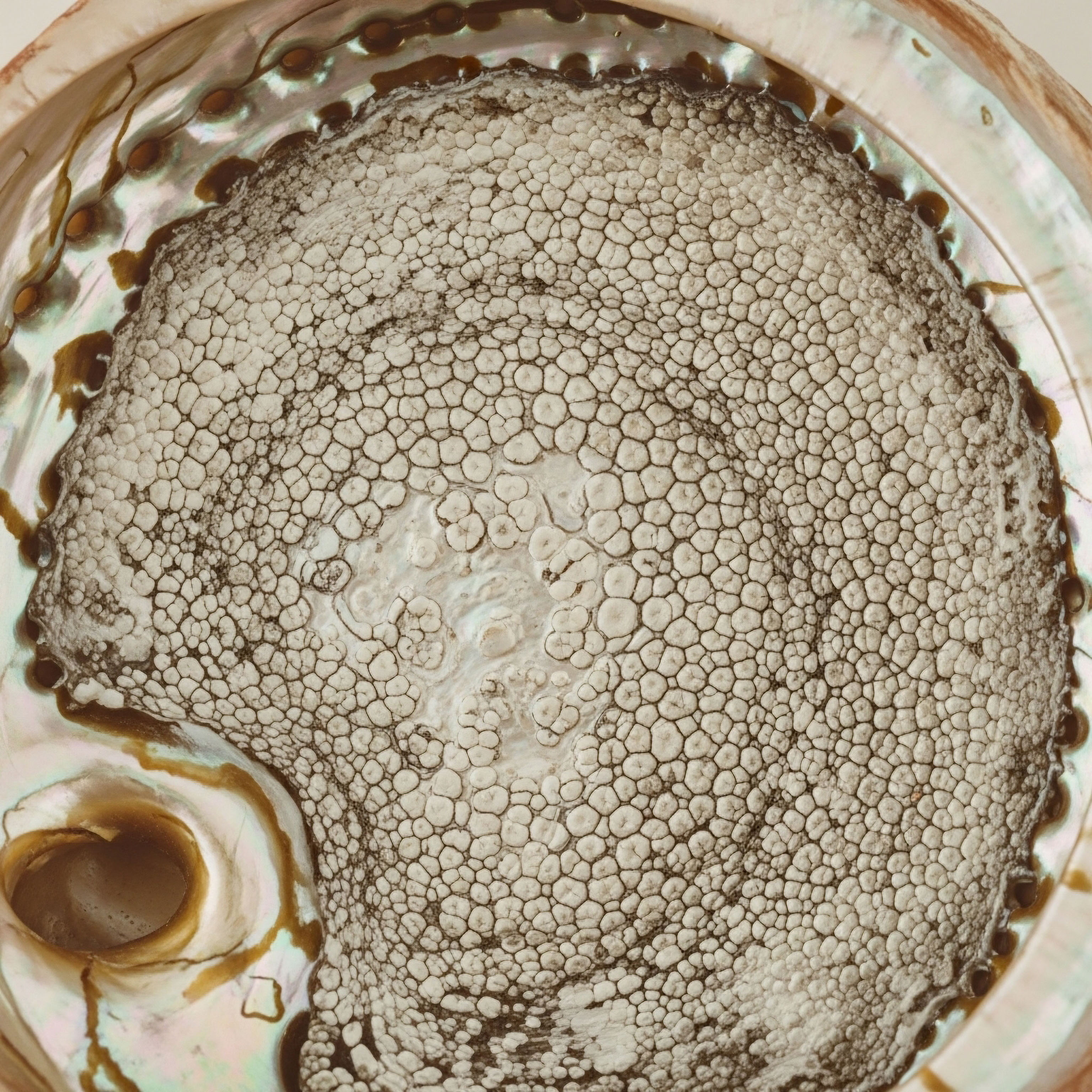

Fundamentals
You feel it in your own body. A subtle shift in energy, a change in the way your clothes fit, a mental fog that descends without clear cause. This lived experience is the starting point of a profound inquiry into your own biological systems.
Your body communicates through an intricate language of chemical messengers, a system of information that dictates vitality, function, and resilience. Understanding this language is the first step toward reclaiming your well-being. The conversation about combined hormone and peptide protocols begins here, with the body’s own signaling architecture.
At the heart of this architecture are hormones and peptides. These are sophisticated information molecules, the body’s internal courier service, delivering critical instructions to every cell. Hormones like testosterone orchestrate broad, systemic processes, from building muscle and bone to regulating mood and cognitive focus.
Peptides, shorter chains of amino acids, often carry more specific, targeted messages, such as instructing the pituitary gland Meaning ∞ The Pituitary Gland is a small, pea-sized endocrine gland situated at the base of the brain, precisely within a bony structure called the sella turcica. to release other hormones or signaling tissues to begin repair processes. Both are fundamental components of a complex, self-regulating network designed to maintain equilibrium, a state of dynamic balance known as homeostasis.

The Body’s Command Center
The primary control system for many of these processes is the Hypothalamic-Pituitary-Gonadal (HPG) axis. This is a three-way communication pathway connecting the brain to the reproductive organs. The hypothalamus acts as the master regulator, sending signals to the pituitary gland.
The pituitary, in turn, releases hormones that travel through the bloodstream to the gonads (testes in men, ovaries in women), instructing them to produce testosterone and other essential sex hormones. This entire system operates on a feedback loop; when hormone levels are sufficient, they send a signal back to the hypothalamus and pituitary to slow down production, much like a thermostat maintains a room’s temperature.
Age, stress, and environmental factors can disrupt this delicate feedback system, leading to the symptoms that initiate a search for answers.

Metabolism the Engine of Vitality
Metabolism is the sum of all chemical reactions that convert food into energy. This energy fuels every cellular action, from muscle contraction to neural firing. Hormones are the primary regulators of this metabolic engine. They determine whether your body burns fat for fuel, stores it for later use, builds new muscle tissue, or breaks down old tissue for recycling.
Testosterone, for instance, promotes an anabolic state, encouraging the body to build and maintain lean muscle mass, which is metabolically active tissue. Growth hormone Meaning ∞ Growth hormone, or somatotropin, is a peptide hormone synthesized by the anterior pituitary gland, essential for stimulating cellular reproduction, regeneration, and somatic growth. and its downstream signal, Insulin-like Growth Factor 1 (IGF-1), also play a central role in tissue repair and energy partitioning. When these hormonal signals decline, the metabolic engine can become less efficient, often leading to an increase in fat mass, a loss of muscle, and a pervasive sense of fatigue.
Combined hormonal therapies initiate a cascade of metabolic adaptations, recalibrating the body’s energy economy.
Entering into a protocol involving both hormone and peptide therapies is a decision to actively participate in this biological conversation. These interventions are designed to restore the clarity and strength of the body’s own internal signals. Testosterone replacement therapy Individuals on prescribed testosterone replacement therapy can often donate blood, especially red blood cells, if they meet health criteria and manage potential erythrocytosis. (TRT) provides a foundational level of the hormone necessary for broad metabolic and structural integrity.
Peptide therapies, such as those that stimulate the body’s own growth hormone production, add a layer of precision, targeting cellular repair and optimizing how the body uses energy. The long-term consequences of this combined approach are a direct result of how these restored signals influence the body’s metabolic machinery over time, shifting the balance from energy storage back toward energy utilization, repair, and revitalization.


Intermediate
Advancing beyond foundational principles requires a closer examination of the specific tools used in hormonal optimization and their intended biological functions. Combined protocols are not a monolithic treatment; they are a carefully orchestrated synergy of different agents designed to restore specific physiological pathways.
Understanding the mechanics of these protocols illuminates how they produce their long-term metabolic effects. The primary goal is to re-establish a hormonal environment that promotes lean mass, efficient fat metabolism, and systemic repair, thereby influencing the body’s metabolic trajectory for years to come.

Dissecting the Protocols
A typical combined protocol integrates a foundational hormone, like testosterone, with a targeted peptide secretagogue. A secretagogue is a substance that causes another substance to be secreted. In this context, peptides like Ipamorelin Meaning ∞ Ipamorelin is a synthetic peptide, a growth hormone-releasing peptide (GHRP), functioning as a selective agonist of the ghrelin/growth hormone secretagogue receptor (GHS-R). or Sermorelin signal the pituitary gland to produce and release its own growth hormone (GH). This approach provides a more pulsatile, natural release of GH compared to direct injection of synthetic HGH.

Testosterone Replacement Therapy the Foundation
For men, a common protocol involves weekly intramuscular or subcutaneous injections of Testosterone Cypionate. This esterified form of testosterone provides a stable, slow-release source of the hormone, establishing a new, consistent baseline. To manage the downstream effects, two other components are often included:
- Anastrozole ∞ An aromatase inhibitor. Aromatase is the enzyme that converts a portion of testosterone into estrogen. While some estrogen is vital for male health, excessive conversion can lead to side effects. Anastrozole modulates this process, maintaining a healthy testosterone-to-estrogen ratio.
- Gonadorelin ∞ A peptide that mimics Gonadotropin-Releasing Hormone (GnRH). When the body receives an external source of testosterone, the HPG axis reduces its own signaling, which can lead to testicular atrophy and reduced natural hormone production. Gonadorelin directly stimulates the pituitary to release Luteinizing Hormone (LH) and Follicle-Stimulating Hormone (FSH), which keeps the testes functional.

Growth Hormone Peptides the Precision Tool
Growth hormone peptides like Ipamorelin and CJC-1295 work in concert. CJC-1295 is a Growth Hormone Releasing Hormone (GHRH) analog that signals the pituitary to prepare a pulse of GH. Ipamorelin, a Ghrelin mimetic, then provides a strong, selective signal for the release of that GH pulse while also reducing the production of somatostatin, a hormone that inhibits GH release.
This dual action creates a potent, yet physiologically controlled, elevation in growth hormone levels. The metabolic effects stem directly from GH’s influence on cellular metabolism.
These protocols are designed to restore not just hormone levels, but the intricate signaling dynamics that govern metabolic health.

What Are the Direct Metabolic Consequences?
When these protocols are combined, their effects on metabolism become synergistic. The long-term consequences are a direct reflection of these sustained physiological shifts. Clinical data and observational studies point toward specific, measurable changes in the body’s handling of glucose and lipids. A retrospective study of patients on long-term testosterone and/or GH supplementation found specific effects on metabolic markers.
For instance, one of the most consistently reported outcomes is a significant change in body composition. Testosterone provides the anabolic signal to build and maintain muscle, while the elevated GH levels from peptide therapy enhance lipolysis, the breakdown of fat for energy. This creates a powerful metabolic shift.
Muscle is highly active tissue, burning calories even at rest, while fat is primarily storage. Over the long term, this recompositioning of the body toward more lean mass Meaning ∞ Lean mass refers to the body’s non-fat components, encompassing skeletal muscle, bone, organs, and water. and less fat mass fundamentally increases basal metabolic rate.
| Therapeutic Agent | Primary Mechanism | Target Gland/System | Primary Metabolic Impact |
|---|---|---|---|
| Testosterone Cypionate | Directly elevates systemic testosterone levels. | Androgen Receptors Throughout Body | Promotes muscle protein synthesis; influences insulin sensitivity. |
| Anastrozole | Inhibits the aromatase enzyme. | Peripheral Tissues (Fat, Muscle) | Modulates estrogen levels, indirectly affecting fat storage and water retention. |
| Gonadorelin | Stimulates pituitary release of LH and FSH. | Pituitary Gland | Maintains endogenous testosterone production and testicular function. |
| Ipamorelin / CJC-1295 | Stimulates endogenous growth hormone release. | Pituitary Gland | Enhances lipolysis (fat breakdown) and tissue repair; can influence glucose metabolism. |
On the level of specific biomarkers, studies have shown that combined therapy can lead to favorable changes in lipid profiles. In some patient groups, particularly those not taking statins, there were observed decreases in total cholesterol and low-density lipoprotein (LDL), often referred to as “bad cholesterol”.
This suggests a long-term benefit for cardiovascular health through improved lipid metabolism. However, the interaction with glucose metabolism is more complex. Growth hormone can induce a degree of insulin resistance, meaning the body’s cells do not respond as efficiently to insulin.
This can manifest as a slight increase in glycated hemoglobin Meaning ∞ Glycated hemoglobin refers to hemoglobin within red blood cells irreversibly bonded with glucose, a process termed glycation. (HbA1c), a measure of long-term blood sugar control. This effect underscores the absolute necessity of careful monitoring and adjunctive lifestyle measures, such as diet and exercise, to maintain excellent insulin sensitivity throughout the protocol.


Academic
A sophisticated analysis of the long-term metabolic consequences of combined hormonal protocols requires moving beyond a simple cataloging of effects on biomarkers. It necessitates a systems-biology perspective, viewing the intervention as a strategic modulation of the neuroendocrine-metabolic axis.
The enduring changes in physiology are the result of pleiotropic effects on gene expression, enzyme activity, and substrate partitioning. The central theme that emerges from a deep examination of the literature is the concept of enhanced metabolic flexibility, a state that has profound implications for healthspan and the mitigation of age-related metabolic disease.

Metabolic Flexibility as the Core Outcome
Metabolic flexibility is the capacity of a system to adapt fuel oxidation to fuel availability. In a healthy state, an individual can efficiently switch between oxidizing carbohydrates for high-intensity energy and oxidizing fatty acids during periods of rest or fasting. A decline in metabolic flexibility Meaning ∞ Metabolic flexibility denotes the physiological capacity of an organism to adapt its fuel utilization based on nutrient availability and energy demand, effectively transitioning between carbohydrate and lipid oxidation. is a hallmark of aging and metabolic syndrome, leading to insulin resistance, dyslipidemia, and ectopic fat deposition. Combined testosterone and GH-peptide protocols directly intervene in the pathways that govern this flexibility.
Testosterone’s role extends to the myocyte, where it upregulates the expression of genes involved in both glycolysis and mitochondrial biogenesis. This prepares the muscle cell to be a more efficient and powerful engine for fuel combustion. The addition of pulsatile GH from peptide therapy further refines this process.
GH is a potent modulator of substrate partitioning. It promotes the mobilization of fatty acids from adipose tissue, increasing their availability as a fuel source for tissues like muscle. This “fat-liberating” effect spares glucose, which is critical for brain function. Over the long term, this sustained signaling pressure trains the body’s metabolic machinery to become more adept at utilizing fats for energy, a key component of metabolic flexibility.

How Do These Protocols Affect Insulin Dynamics?
The relationship between the somatotropic axis Meaning ∞ The Somatotropic Axis refers to the neuroendocrine pathway primarily responsible for regulating growth and metabolism through growth hormone (GH) and insulin-like growth factor 1 (IGF-1). (GH/IGF-1) and insulin is complex and often misunderstood. While supraphysiological levels of GH are known to be diabetogenic, the carefully managed, pulsatile release stimulated by peptides presents a different picture. GH can induce a transient, physiological state of insulin resistance, primarily in skeletal muscle.
This effect is a feature of its glucose-sparing action. By slightly reducing muscle glucose uptake, GH ensures a stable supply of glucose for the central nervous system. A retrospective analysis of patients on long-term therapy showed that while glycated hemoglobin could increase slightly in some groups, insulin levels did not show a significant change, suggesting the body adapts without progressing to a pathological state of hyperinsulinemia.
The key determinant of a positive versus negative outcome is the patient’s baseline metabolic health Meaning ∞ Metabolic Health signifies the optimal functioning of physiological processes responsible for energy production, utilization, and storage within the body. and the inclusion of lifestyle interventions, particularly resistance training, which independently and powerfully enhances insulin sensitivity Meaning ∞ Insulin sensitivity refers to the degree to which cells in the body, particularly muscle, fat, and liver cells, respond effectively to insulin’s signal to take up glucose from the bloodstream. via non-insulin-dependent pathways (e.g. GLUT4 translocation).
| Metabolic Marker | Influence of Testosterone | Influence of GH Peptides | Combined Long-Term Consequence |
|---|---|---|---|
| Fasting Insulin | Can improve insulin sensitivity, potentially lowering levels. | May slightly increase insulin resistance, potentially raising levels. | Net effect is highly dependent on dosage, patient baseline, and lifestyle. Monitoring is essential. |
| Glycated Hemoglobin (HbA1c) | Generally neutral or slightly improved with better body composition. | Can cause a minor, statistically significant increase, though often within normal range. | Requires vigilant monitoring to ensure the patient remains in a state of euglycemia. |
| LDL Cholesterol | Can contribute to reductions, especially with improved metabolic health. | Contributes to improved lipid profiles. | Observed decreases in total cholesterol and LDL in certain patient cohorts. |
| Triglycerides | Improved insulin sensitivity can lower triglycerides. | Potent effect on lipolysis can lower circulating triglycerides. | Significant decreases observed, particularly in patients also on statin therapy. |
| Lean Body Mass | Strongly promotes muscle protein synthesis. | Supports tissue repair and IGF-1 production, aiding muscle growth. | Synergistic and substantial gains in lean mass, which increases basal metabolic rate. |

The Systemic View an Integrated Perspective
The long-term metabolic consequences are therefore an emergent property of a system being recalibrated. It is the result of restored anabolic signaling (testosterone) combined with optimized nutrient partitioning and repair signaling (GH peptides). The observed improvements in body composition Meaning ∞ Body composition refers to the proportional distribution of the primary constituents that make up the human body, specifically distinguishing between fat mass and fat-free mass, which includes muscle, bone, and water. are not merely aesthetic; they represent a fundamental shift in the body’s metabolic posture.
A body with more lean mass and less visceral fat is a body that is more insulin-sensitive, less inflamed, and more resilient to metabolic insults. Research has demonstrated that these therapies, when administered in physiological doses to appropriate populations, result in gains in lean mass and strength, and reductions in fat mass.
The very low incidence of adverse clinical outcomes in long-term retrospective surveys further supports the position that when managed correctly, these protocols do not appear to negatively impact metabolic health and may confer protective benefits. The ultimate trajectory depends on a comprehensive approach that views the protocol as one component within a larger framework of nutrition, exercise, and diligent clinical monitoring.
The intervention recalibrates the body’s metabolic posture toward a state of increased resilience and functional capacity.
The critical insight for the clinician and the informed patient is that these protocols are not a passive treatment but an active metabolic intervention. Their success is measured not just by the normalization of a single hormone level, but by the functional improvement of the entire metabolic system.
The long-term consequences are written in the language of improved lipid profiles, stable glycemic control, enhanced body composition, and a restored capacity for the body to efficiently manage energy. This is the biological foundation of sustained vitality.

References
- Ginzburg, Enrique, et al. “Long-term Safety of Testosterone and Growth Hormone Supplementation ∞ A Retrospective Study of Metabolic, Cardiovascular, and Oncologic Outcomes.” Journal of Clinical Medicine Research, vol. 3, no. 1, 2011, pp. 15-22.
- Blackman, Marc R. et al. “Effects of Growth Hormone and/or Sex Steroid Administration on Body Composition in Healthy Elderly Women and Men.” The Journal of Clinical Endocrinology & Metabolism, vol. 87, no. 3, 2002, pp. 1024-1033.
- Sattler, Fred R. et al. “Testosterone and Growth Hormone Improve Body Composition and Muscle Performance in Older Men.” The Journal of Clinical Endocrinology & Metabolism, vol. 94, no. 6, 2009, pp. 1991-2001.
- Sand Institute. “TRT testosterone replacement therapy combined with the use of a GHRH Peptide.” Sand Institute Blog, 23 Apr. 2019.
- Innovation HRT Clinic. “The Synergistic Benefits of Combining Testosterone Replacement Therapy (TRT) and Human Growth Hormone (HGH).” Innovation HRT Clinic Blog.

Reflection

Charting Your Biological Narrative
The information presented here offers a map of the complex biological territory you are considering navigating. This knowledge provides coordinates, landmarks, and potential routes. Yet, a map is not the journey itself. Your personal health story, with its unique history, symptoms, and goals, is the true compass.
The data and mechanisms provide the scientific grammar, but you are the author of the narrative. How do these concepts of metabolic flexibility and systemic balance resonate with your own lived experience of well-being? Consider this exploration the beginning of a more profound dialogue with your own physiology, a conversation guided by data but ultimately focused on your unique path to sustained function and vitality.















